See also:
Workers Museum in Copenhagen, 2023-05-12
Copenhagen, 2023-05-12
Copenhagen, 2023-05-13
To download a hi-res version of any photo, click on it. Photo numbers are above each photo.
Our visit to the
Museum of Danish Resistance was difficult. The overwhelming sadness of the pain and loss of life in World War II and the Holocaust combined with concerns about how the Museum chose to tell the story of resistance in Denmark.
I tried to approach this museum with the humble understanding that I don't know what I would have done in the situation of the Danes in the 1940's. I hope I would have found non-violent and effective means to resist, means that would be inviting to others.
However, I am also inspired by the large numbers of Danes who chose to wear yellow stars in solidarity with their Jewish neighbors, who took in those Jewish neighbors to serve as a sanctuary, and assist them when they needed to escape to Sweden. This is a story that I found de-emphasized at the Museum, in favor of a story of radicals engaged in sabotage that provoked German retaliation, and a Danish establishment that urged against radicalism and aligned itself austensibly with Germany and secretly with Britain.
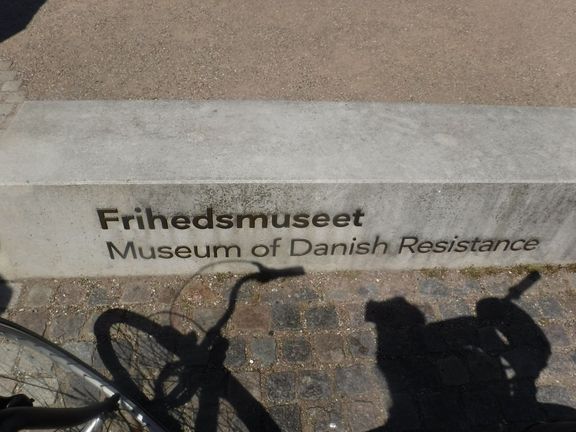
93: This poster informed Danes of the King's encouragement to demonstrate "calm and dignity" and "obey authorities."
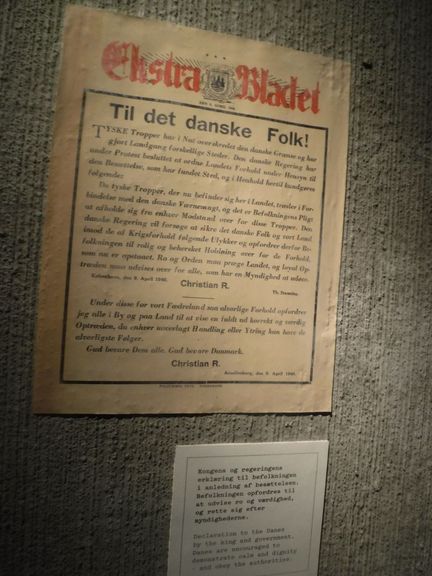
94: This exhibit displayed ways that Danish Nazis (called DNSAP) supported the philophy of the German occupiers, but also sought their own share of political power, constrained by the Germans who found it advantageous to work with Danish authorities. DNSAP found ways to present fascism in a style familiar to the Danish people.
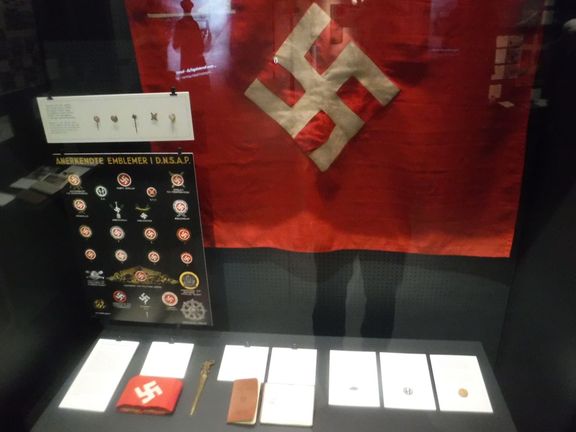
95
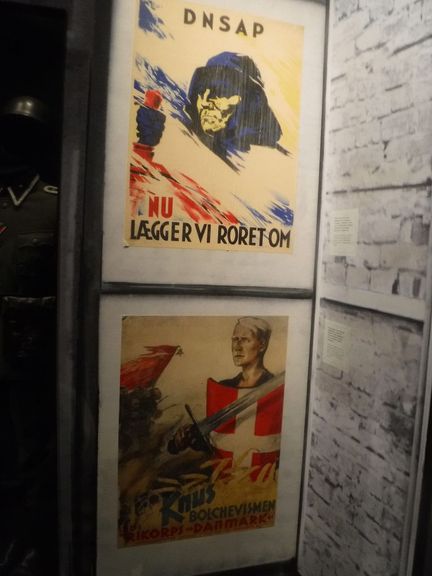
96: A wooden tray from
Horserød camp where leaders of
Denmark's Communist Party were imprisoned. At Germany's urging, Danish police had arrested 300 party members and the Danish Parliament passed an Anti-Communist Act on August 22, 1941. Instead of emphasizing these facts, the Museum presented this tray made by prisoners.
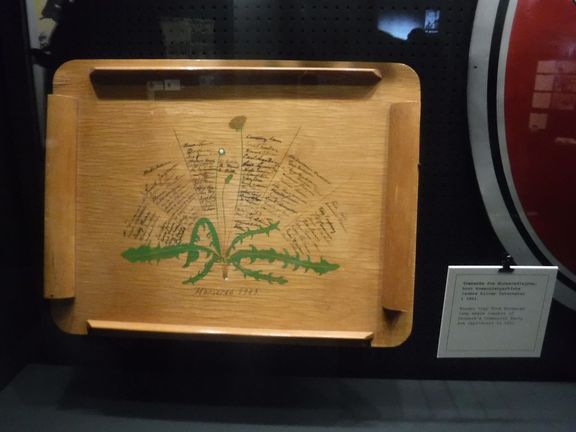
97
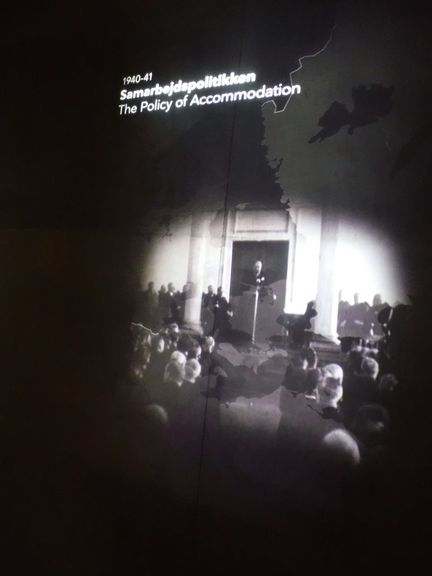
98: This display shows ephemera of daily life with monetary stamps and ration coupons.
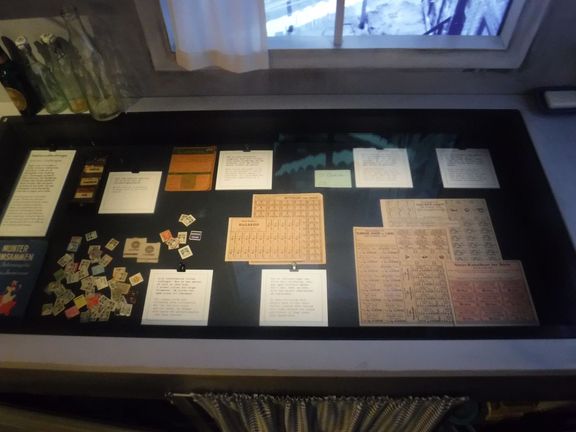
99: The "Scene 5" panel says, "In the beginning they are few. A couple of thousand at most are active in the Danish Resistance. People join for different reasons. Patriots and conservatives are driven by shame and national sentiment. Imagine that Denmark was occupied virtually without a fight. They are resisting occupation for a free Denmark."
"For the Communists" the panel adds, "fighting the Nazis is just one step on the way to a Communist world order and Communist Denmark in the long run."
So, I am inferring that the Museum is saying that "Communists" are not like "People" who "join for different reasons." They apparently feel no "shame" or "sentiment." They have no concern for present human needs, but instead see "just one step on the way to a Communist world order".
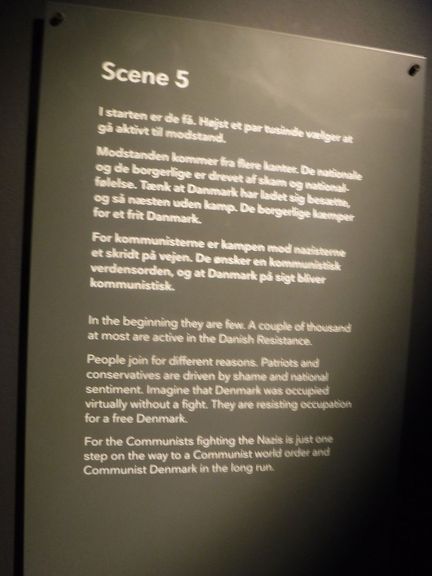
100: This map shows the number of acts of sabotage committed in different parts of Denmark between 1940 and August 29, 1943 (when the Danish government collapsed and Germany began ruling with emergency decrees).
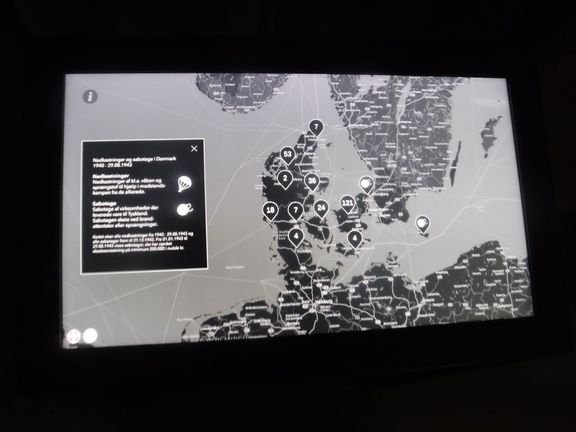
101: This panel pretends that all Communists think alike and follow orders from Moscow. "In the beginning, their means are primitive and the impact of their sabotage limited." In the end, though, the Museum doesn't assess the legacy of resistance that flowed from this beginning.
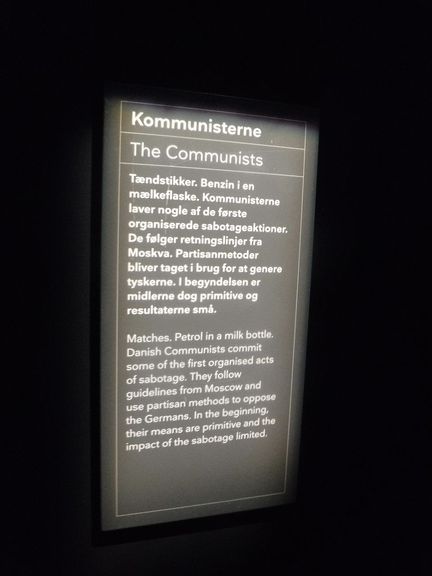
102: Below, a Communist pamphet disguised as a song book. Above, a matchbox with the King's picture replaced by Stalin's. It is hard to see now how that replacement would have furthered any cause.
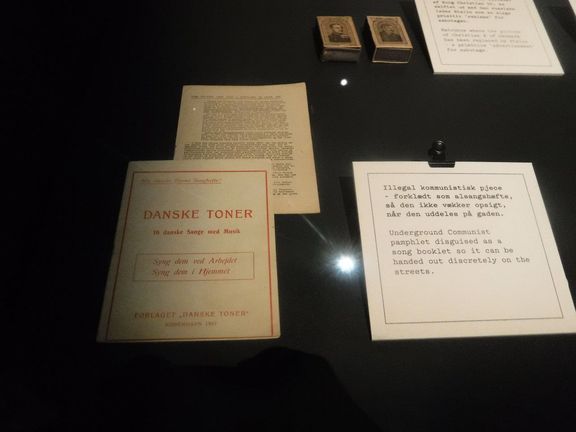
103: A pipe bomb of the type Communists used on May 1, 1943, at a steel factory. Only one worked.
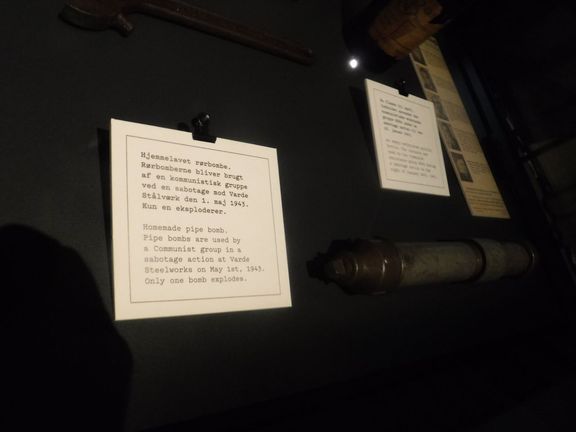
104: Young "Patriotic" mobilizers used underground newspapers and were "uncoordinated." They also engage in sabotage.
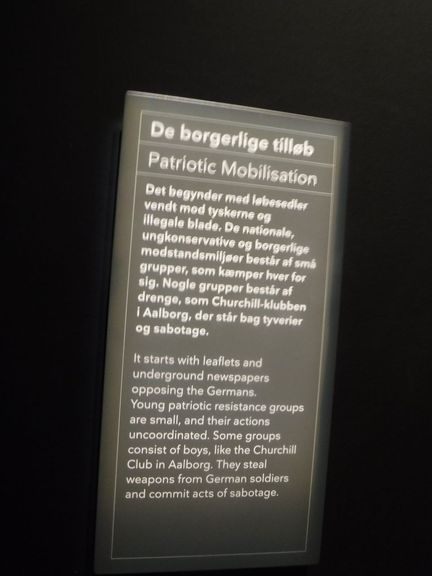
105: This exhibits shows a picture of seven members of the Churchill Club, and a comic book that exaggerated their activities.
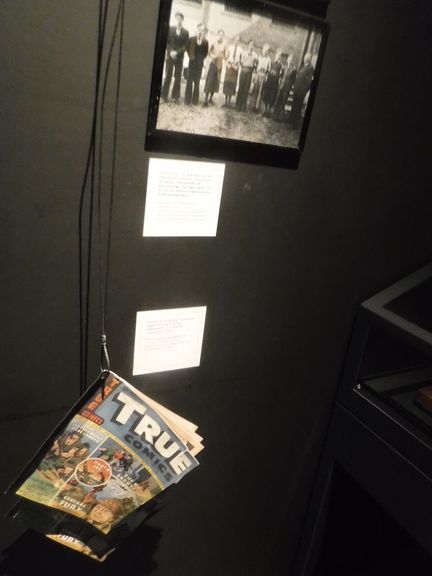
106: Silk screen press used to print one flyer at a time.
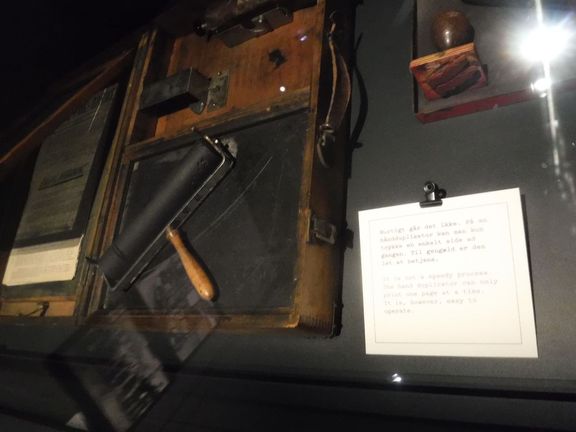
107: Stamps used to add graphics to publications.
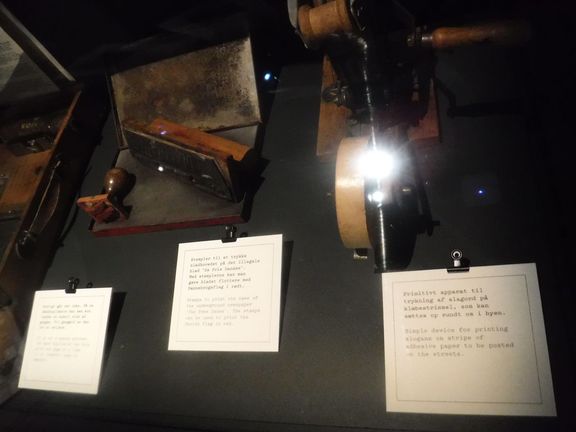
108: This panel protrays the official Danish military intelligence service as the true heroes who helped smuggle information to Stockholm and London. No mention of whether any of this information also got to Moscow.
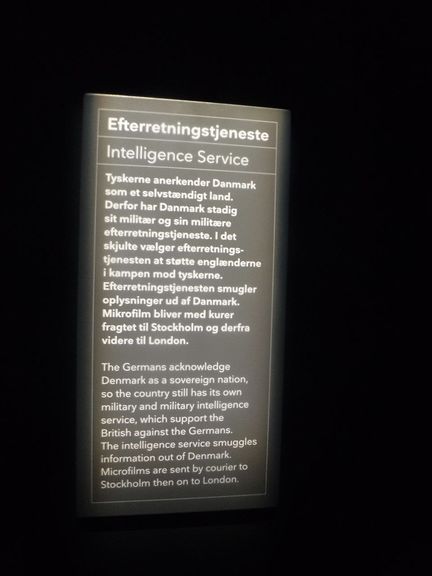
109: Means used to conceal microfilm.
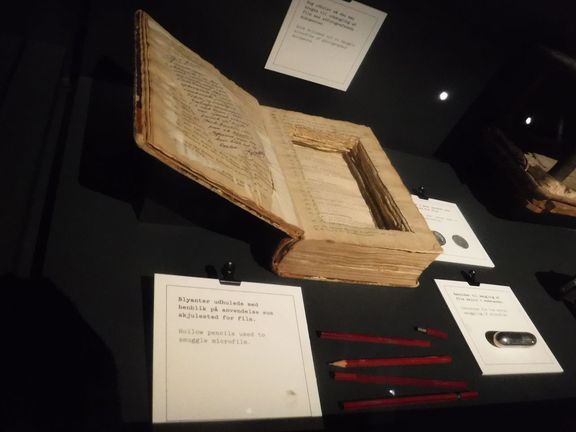
110
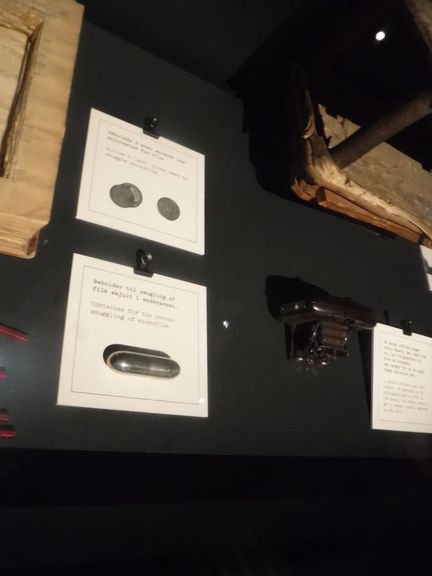
111
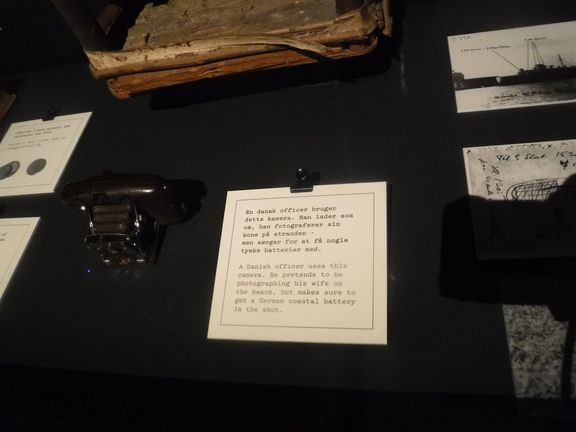
112: The Museum exhibits are often vague about the timeline. Presumably, this panel is about a May 1943 speech by King Christian X calling for "order, a necessity if the country is to hold its own." Strangely, Danes have different ideas.
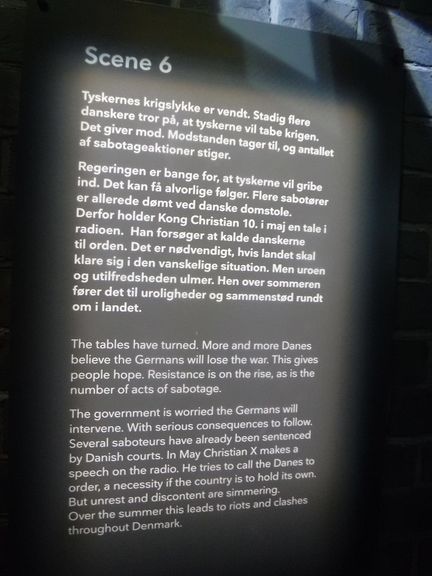
113: Danish workers go on strike in August 1943.
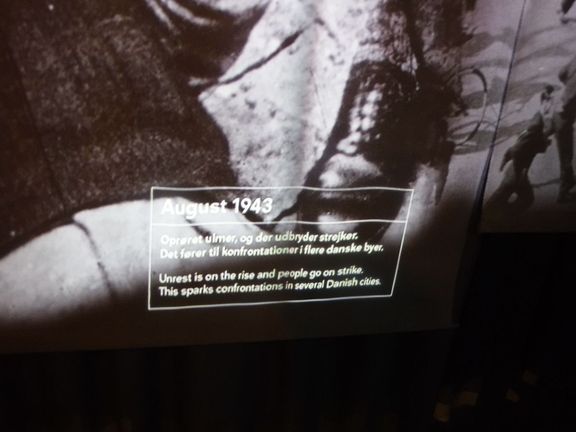
114: After the Danish government refuses to approve martial law and the death penalty for sabotage, Germany declares a state of emergency and takes over as the Danish government "ceases to function."
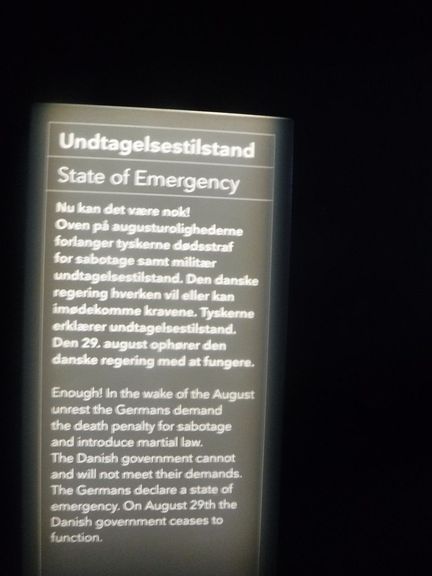
115
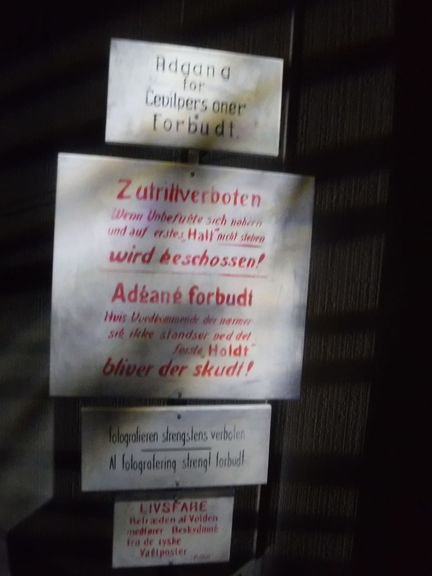
116: Finally, after telling the story through the demise of the Danish government, the Museum mentions the Jews. Here is a boat used to sail Jews to Sweden on October 1, 1943.
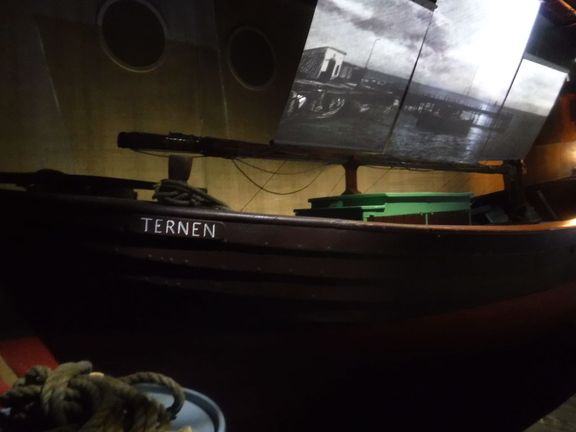
117: This correspondence between the King and Prime Minister discusses the prospect of Germany requiring Jews to wear the yellow star. They agree German demands should be rejected. The King adds that if Gemany so demands, then "it would be best countered by all Danes wearing 'the Star of David'." This exhibit does not say if the demand was made, if the King so countered or if the Danish people all took up the Star of David in one of the most dramatic acts of solidarity in all of human history.
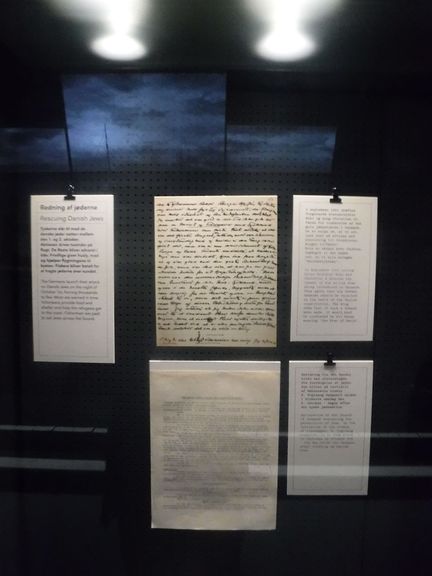
118: A pillow with a hole from a bullet that missed the infant sleeping on it. A bottle of a pharmacist's concoction to deaden the smell of scent tracking dogs, and a telephone used to coordinate passage of Jews from Denmark to Sweden.
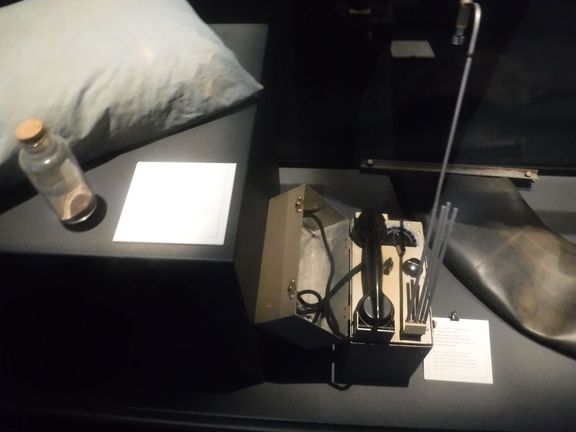
119: Now that the resistance has become more popular in 1944, the Museum provides less detail about who is leading it.
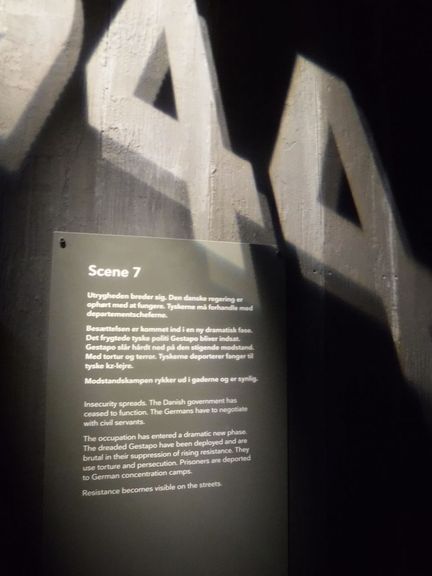
120: This is the only yellow star I saw in the Museum. It is protrayed as one worn by a Jew.
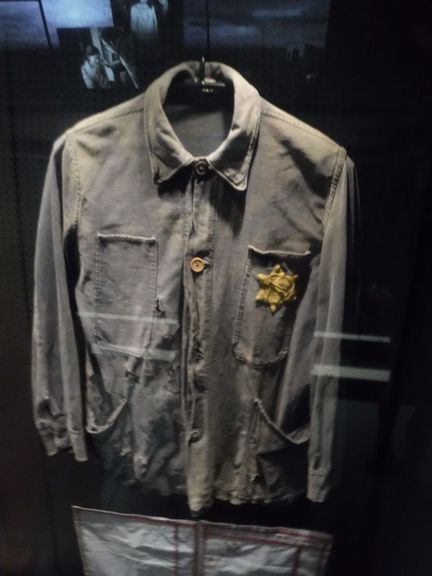
121: Gestapo book of captured and suspected resistance leaders.
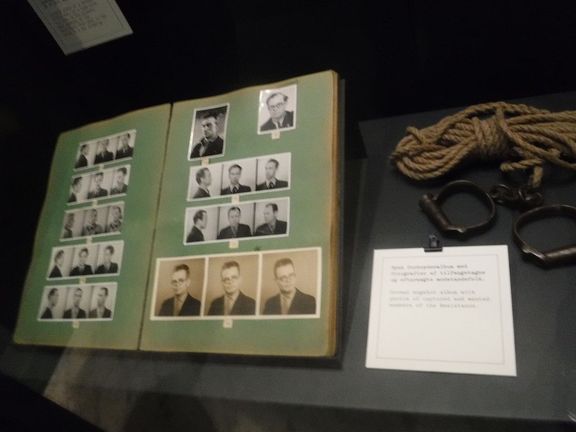
122: The Museum portrays how the Gestapo used informers to identify resistance leaders to arrest, torture and execute. It also states that resistance fighters also killed those suspected of being informants, about 400 of them.
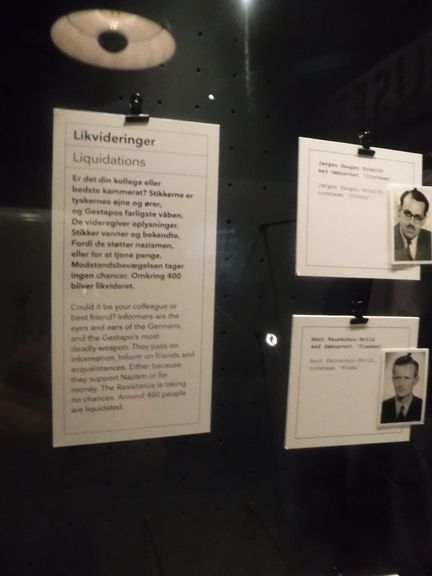
123: Hat worn by editor
L. V. Jensen when Germans shot him in a November 13, 1944, "reprisal killing."
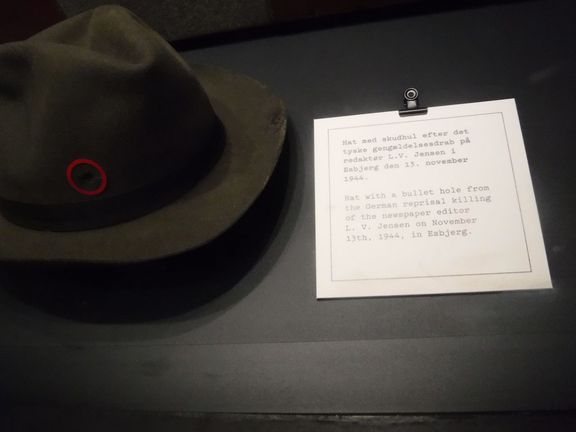
124: Germany's announcement of a curfew provokes a general strike in Copenhagen.
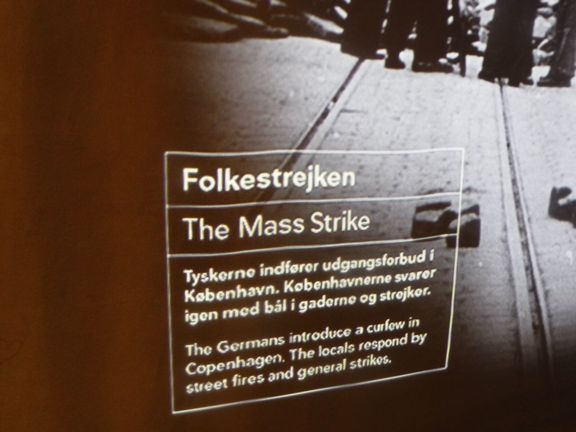
125: After the collapse of the Danish government, local councils selected "watchmen" who had truncheons and not guns.
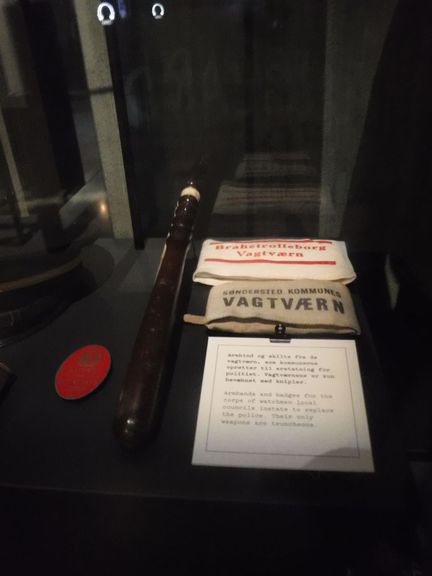
126: Danish "authorities" and "unions" urge Danes to call off the strike before "Germans lose patience". You would hate to see that. Some might even say that maybe we should blame the Nazis for what the Nazis do.
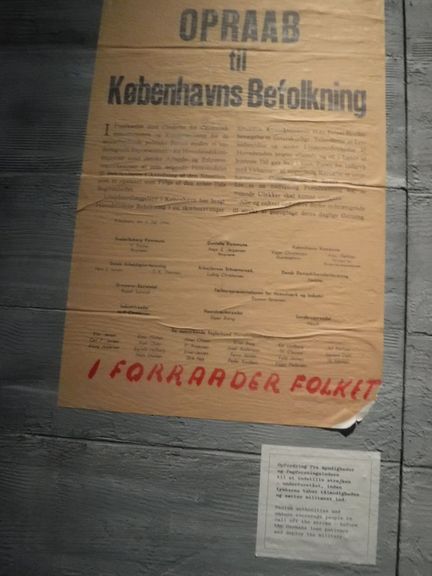
127: Germany announces a blockage of Copenhagen in an effort to break the general strike.
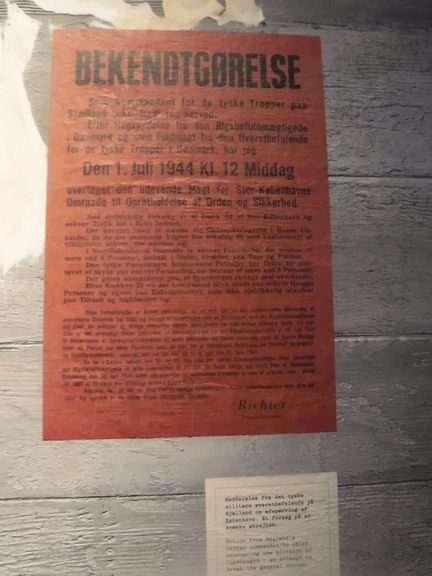
128: The Danish Freedom Council flyer urges continuation of the strike until Germany makes concessions.
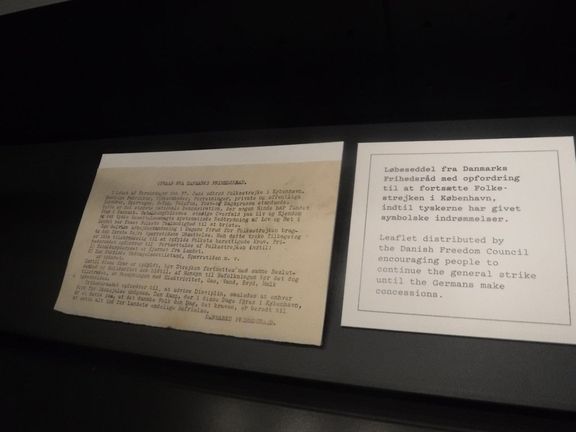
129: Germany does make concessions to end the strike!
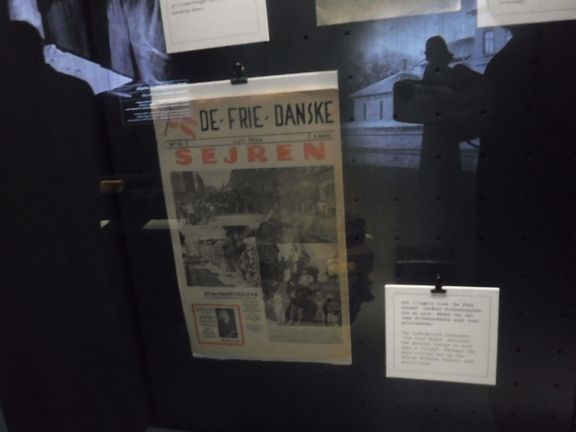
130: The Danish Freedom Council leaflet explains its post-war program.
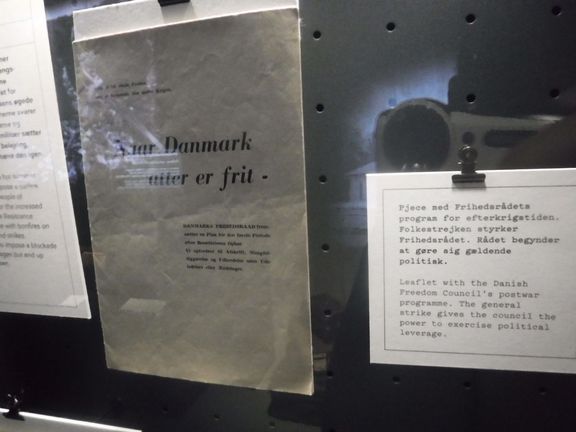
131: To impede the flow of supplies from Norway, Danish Resistance fighters use botton-activated bombs to blow up trains and their tracks.
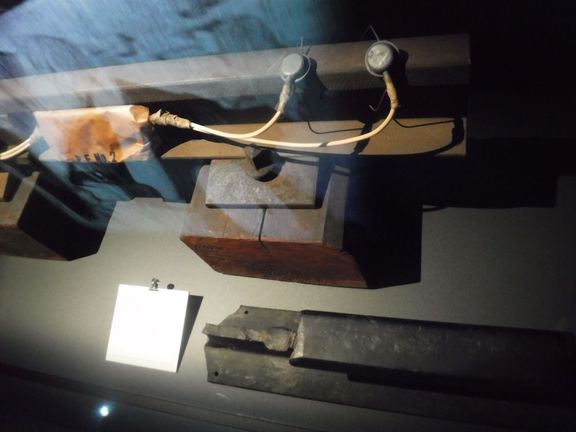
132
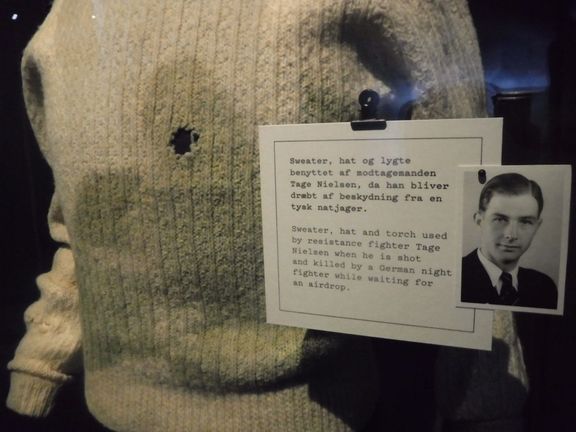
133: A Red Cross package for detainees is a life saver.
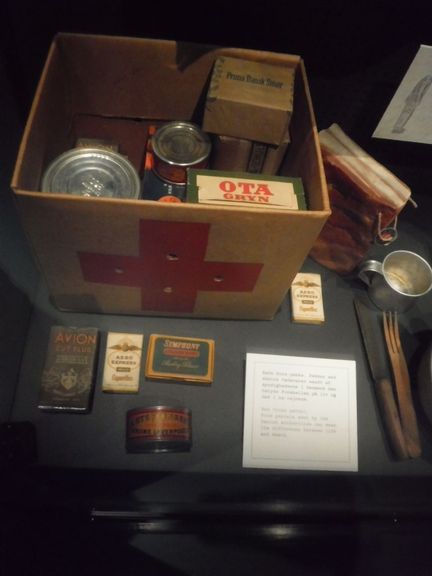
134: Concentration camps included Jews, Communists, Resistance members, police officers and other so-called "asocials."
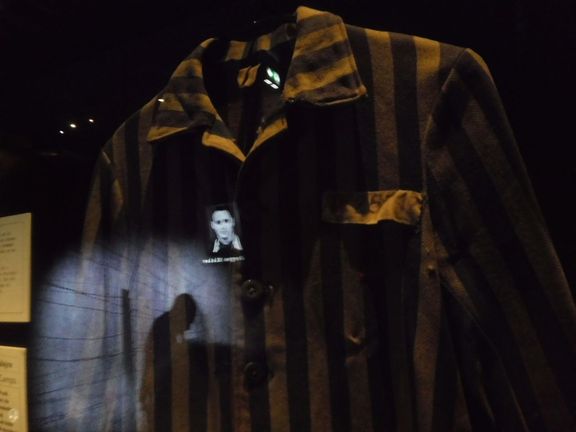
135: A bowl and spoon are necessities for survival in the concentration camps.
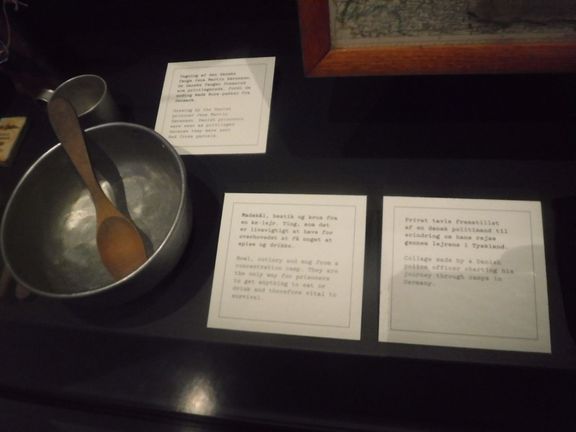
136: On March 21, 1945, Britain carries out a bombing of German headquarters at the request of the Resistance. Unfortunately, the bombs hit a French school and residential neighborhood instead, taking civilian lives.
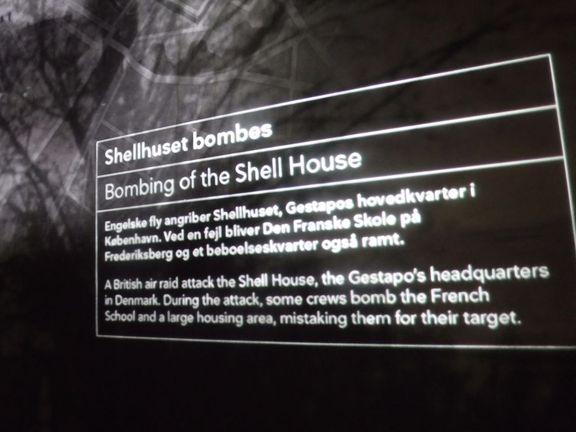
137
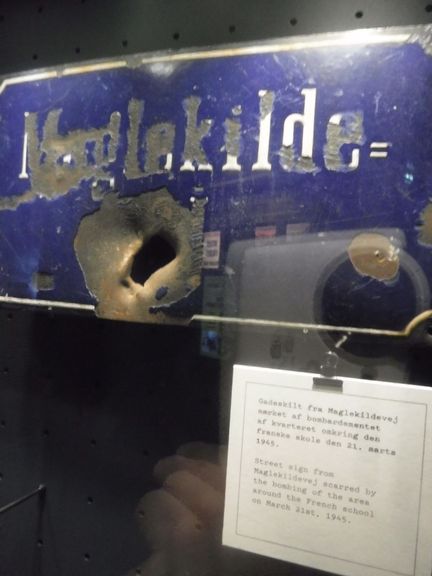
138
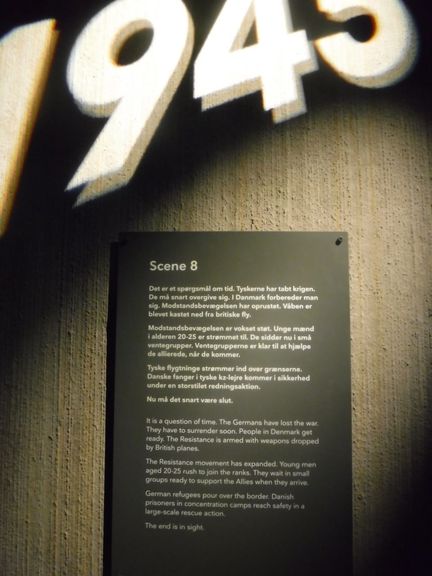
139: I found this exhibit most moving. German officials used these three pine logs in the executions of dozens of Resistance members at Ryvang Barracks -- mostly at the very end of the war.
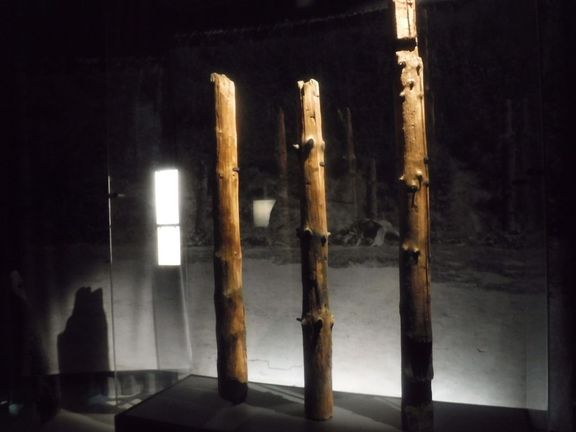
140: Liberation is announced on May 4, 1945.
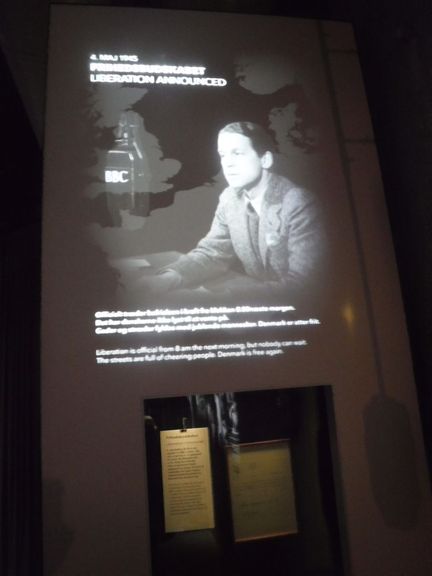
141: Instrument of surrender signed by DNSAP.
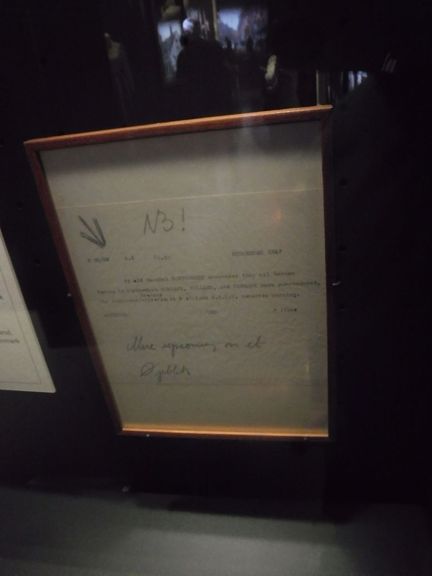
142: Show of affection for the colors of the Union Jack.
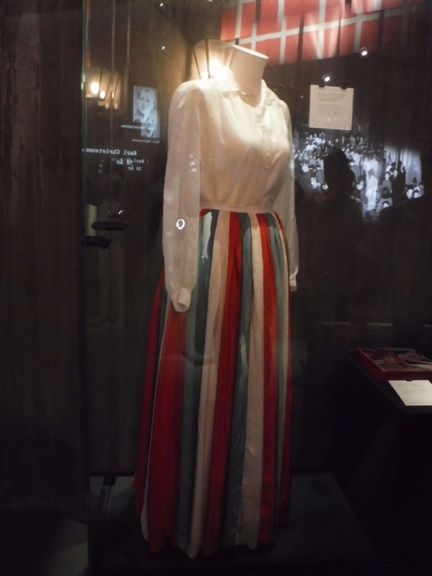
143: This "Back to Normal" panel ignores how the post-war liberation government included both the Danish Freedom Council and the pre-war unity government. Two members of the Communist Party of Denmark served as ministers while the Social Democrats were decimated after their failure to resist the German occupation.
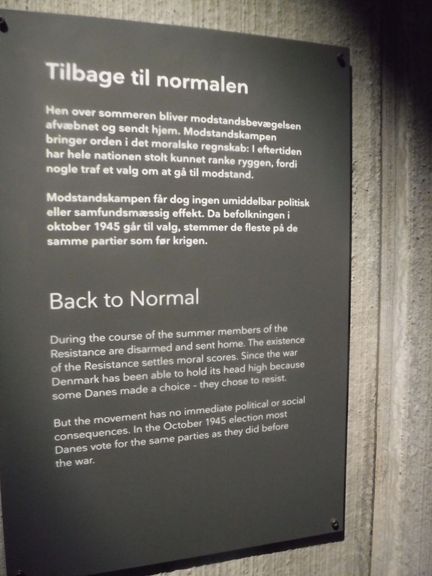
At the end of our visit, I chatted with some of the Museum employees and shared my concern that the Museum had little mention of how Danes saved their Jewish communities by widespread solidarity and sanctuary. The story of non-violent resistance is largely untold. They responded that their Museum is intended for young people who no longer have living relatives who lived during World War II. They also explained that the resistance was complicated, and the Museum strives to convey that resistance was neither uniform nor easy.

I left with the Museum staff a copy of the sheet of these 1985 Danish stamps (and my new business card). The stamps commemorate the liberation of Denmark, and the lifting the blinds that hid Danish Jews from the Germans and saved their communities. My mother cherished a framed sheet of these stamps in her kitchen for decades, and they hang now in our kitchen. If the Danish postal service can see the significance of this widespread, non-violent act of resistance, why can't the Museum of Danish Resistance tell the rest of us about it? I await the Museum's reply.
See also:
Workers Museum in Copenhagen, 2023-05-12
Copenhagen, 2023-05-13
Copenhagen, 2023-05-12
Rob and Robin's wedding, 2023-03-26
Audrey's 8th Birthday, 2023-02-26
Thanksgiving, 2022
Halloween, 2022-10-31
David Percy, In Memoriam, 1959-02-13 to 2022-09-28
Ron & Robin's Walk and Rehearsal Dinner, 2022-06-11
Memorial Day 2022
Luray Caverns, 2022-05-29
Udvar-Hazy Air and Space Museum, 2022-05-27
Audrey to 2022-04-24
Robin graduates from Union Theological Seminary, 2018-05-18
Robin Stillwater's graduation from Davis & Elkins College, 2014-05-16
Let me know your reaction to these photos.
Click here to send me an email.
Me gustaría saber su opinion.
Haga clic aquí para enviarme un email.
 I left with the Museum staff a copy of the sheet of these 1985 Danish stamps (and my new business card). The stamps commemorate the liberation of Denmark, and the lifting the blinds that hid Danish Jews from the Germans and saved their communities. My mother cherished a framed sheet of these stamps in her kitchen for decades, and they hang now in our kitchen. If the Danish postal service can see the significance of this widespread, non-violent act of resistance, why can't the Museum of Danish Resistance tell the rest of us about it? I await the Museum's reply.
I left with the Museum staff a copy of the sheet of these 1985 Danish stamps (and my new business card). The stamps commemorate the liberation of Denmark, and the lifting the blinds that hid Danish Jews from the Germans and saved their communities. My mother cherished a framed sheet of these stamps in her kitchen for decades, and they hang now in our kitchen. If the Danish postal service can see the significance of this widespread, non-violent act of resistance, why can't the Museum of Danish Resistance tell the rest of us about it? I await the Museum's reply.